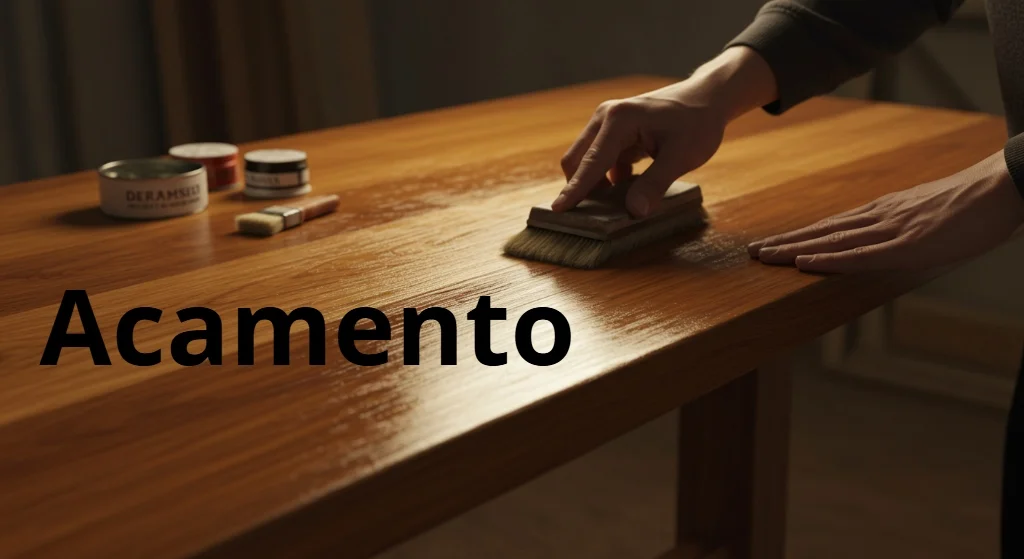In today’s design-driven world, the word acamento is gaining traction across industries—from architecture and furniture to product design and digital manufacturing. But what exactly does it mean? Is it just another fancy word for “finishing,” or does it represent something deeper—perhaps a new philosophy about the way we treat surfaces, materials, and user experiences?
Let’s take a deep dive into the concept of acamento—its origins, core principles, practical uses, and why it’s becoming a modern-day essential across both creative and industrial fields.
Understanding Acamento: More Than Just Finishing
At its simplest, acamento refers to the final process applied to a material or product surface to enhance its appearance, performance, or functionality. While it shares roots with the Portuguese term acabamento, meaning “finishing,” acamento has evolved to embody a broader concept.
Unlike traditional finishing, which focuses primarily on protection and shine, acamento integrates aesthetics, sensory experience, sustainability, and technological enhancement. It’s not just about how something looks—it’s about how it feels, performs, and interacts with its environment.
Think of it as the final layer of intention. Whether it’s the smooth feel of a smartphone case, the soft matte finish of a car dashboard, or the water-repellent coating on outdoor furniture, acamento defines the last touch that bridges craftsmanship and innovation.
The Philosophy Behind Acamento
The philosophy of acamento is rooted in balance—between beauty and durability, art and engineering, tradition and innovation. In essence, acamento is about refinement. It’s where creativity meets precision.
1. Function Meets Form
Acamento is not just cosmetic. Every layer, polish, or treatment serves a functional purpose—resisting corrosion, enhancing grip, or improving reflectivity. The goal is to make the product as functional as it is beautiful.
2. Sensory Experience
Acamento appeals to the senses. The texture you feel, the light you see, even the sound a product makes when you touch it—these are deliberate design choices embedded in the acamento process.
3. Sustainability
Modern acamento practices emphasize eco-conscious methods: low-VOC coatings, water-based finishes, and recyclable materials. The process aims to minimize waste and toxicity without compromising quality.
4. Digital Integration
With the rise of smart materials and 3D printing, acamento has entered the digital era. Today, designers can simulate finishes virtually before they’re physically applied, optimizing texture, reflectivity, and performance with computer precision.
Types of Acamento: Exploring Surface Varieties
Acamento can be categorized based on texture, material, or application purpose. Below are the most common types used across different industries:
1. Matte Acamento
A soft, non-reflective surface that absorbs light instead of reflecting it. Matte finishes are favored for their elegant, modern look and fingerprint resistance. They’re often used in interior design, electronics, and luxury vehicles.
2. Glossy Acamento
The opposite of matte, glossy finishes reflect light and create a sleek, polished look. Ideal for products aiming to stand out visually—like ceramic tiles, appliances, and high-end furniture.
3. Textured Acamento
These surfaces are intentionally uneven to create a tactile feel or visual depth. Common examples include brushed metal, wood grain laminates, or sand-textured wall paints. Beyond aesthetics, texture adds grip and hides imperfections.
4. Metallic Acamento
Used in industrial and automotive applications, metallic acamento enhances durability while giving surfaces a sophisticated metallic luster. It’s often achieved through electroplating or powder coating techniques.
5. Transparent or Clear-Coat Acamento
This type preserves the natural look of the base material while adding protection. Often used on wood, metal, and concrete surfaces, it provides resistance against moisture, UV rays, and scratches.
6. Hybrid and Smart Acamento
The future of finishing lies in intelligent surfaces. Hybrid acamento can include anti-bacterial coatings, self-healing layers, or thermochromic (temperature-reactive) finishes. These innovations redefine how we interact with materials.
The Process of Acamento: From Preparation to Perfection
While each industry adapts the process differently, the core stages of acamento share a common flow. Each step determines the quality and longevity of the finish.
1. Surface Preparation
Before any coating or treatment, surfaces must be cleaned, sanded, or polished to remove dust, grease, and imperfections. This ensures better adhesion and smoother results.
2. Priming or Sealing
A primer or sealant acts as the foundation layer, improving bonding and preventing material reactions like rust or discoloration. For porous materials like wood or concrete, sealing is essential to reduce absorption.
3. Application of Coating
The acamento layer is applied through brushing, spraying, dipping, or digital printing—depending on the material and desired effect. Advanced techniques like vapor deposition or nanocoating are also used for high-precision finishes.
4. Curing and Drying
This stage solidifies the coating and enhances durability. Some finishes require heat, UV light, or chemical curing to achieve the final texture and strength.
5. Quality Control
The finished surface undergoes visual and mechanical testing to ensure consistency in color, texture, and performance under different environmental conditions.
Benefits of Acamento: Why It Matters
The advantages of acamento go far beyond appearance. It’s a value-adding process that directly impacts the usability, lifespan, and sustainability of products.
1. Enhanced Durability
Proper acamento protects surfaces from wear, moisture, corrosion, and UV damage. It acts as a shield, extending the lifespan of both everyday and industrial products.
2. Improved Aesthetics
A well-designed finish can elevate even a basic product. Acamento offers infinite visual possibilities—glossy, matte, metallic, or hybrid—giving designers creative freedom.
3. Better User Experience
Texture and tactile feedback can influence user perception. Smooth surfaces feel luxurious, while textured finishes improve grip and practicality.
4. Environmental Resistance
Specialized acamento coatings can make materials weatherproof, dustproof, or chemical-resistant—critical for outdoor applications and industrial machinery.
5. Eco-Friendliness
Modern acamento technologies focus on biodegradable or water-based materials, minimizing harmful emissions. Sustainable finishing is now a key selling point in green manufacturing.
6. Customization
Advancements in technology have made acamento highly customizable. From digital simulations to 3D-printed textures, creators can now achieve precision and uniqueness in every project.
Acamento Across Industries
1. Architecture and Interior Design
In architecture, acamento defines ambiance. From polished marble floors to matte concrete walls, finishes influence how a space feels and functions. Architects use acamento to balance durability with visual appeal, ensuring longevity in high-traffic areas.
2. Automotive and Aerospace
Vehicles rely on acamento for both protection and style. Anti-scratch, UV-resistant, and hydrophobic coatings maintain paint integrity. In aerospace, heat-resistant acamento safeguards components from extreme temperatures.
3. Consumer Electronics
The tactile smoothness of your smartphone or the sleek sheen of a laptop is no accident. Acamento enhances the feel, look, and even the cooling properties of electronics.
4. Furniture and Decor
From lacquered wood to brushed metal handles, acamento determines how furniture interacts with light and touch. Designers use finishes to express style—minimalist, rustic, or futuristic.
5. Industrial Manufacturing
In manufacturing, acamento is vital for corrosion protection, friction control, and energy efficiency. Surface engineering ensures that machinery operates smoothly and safely under harsh conditions.
Modern Innovations in Acamento
The concept of acamento continues to evolve as technology reshapes materials science. Here are the emerging trends redefining the industry:
1. Smart Coatings
Surfaces that heal minor scratches, repel water, or change color under heat are no longer science fiction. Smart acamento enhances both functionality and lifespan.
2. Nanotechnology Integration
Nano-acamento uses microscopic particles to strengthen coatings and make them more adaptive. For instance, nano-ceramic finishes in cars offer unmatched gloss and protection.
3. Eco-Conscious Materials
With rising environmental awareness, acamento has shifted toward water-based, non-toxic, and recyclable materials. This move supports global sustainability efforts.
4. Digital and Augmented Reality (AR) Prototyping
Designers now visualize and modify finishes digitally before production. AR tools help predict how surfaces will react to light, texture, and movement.
5. 3D Printing in Surface Design
3D printing allows manufacturers to imprint textures or micro-patterns directly onto surfaces, reducing the need for chemical coatings and promoting material efficiency.
Challenges in Acamento
Despite its advantages, acamento is not without challenges. Common issues include:
- Cost Overruns: High-quality materials and technology-driven finishes can be expensive.
- Environmental Factors: Humidity and temperature fluctuations can affect curing and adhesion.
- Maintenance Needs: Some finishes require periodic renewal to maintain their properties.
- Skill Dependency: Achieving consistency demands trained professionals and precision tools.
Addressing these challenges involves innovation, skill development, and stricter quality controls across industries.
Future of Acamento: Where Design Meets Technology
The future of acamento lies in adaptive surfaces—materials that respond to environmental changes or user behavior. Imagine walls that adjust their texture to absorb sound, or car exteriors that self-clean after a storm.
Research in materials science and AI-driven design will likely make acamento more dynamic, sustainable, and interactive. As industries shift toward personalization and eco-friendliness, acamento will become not just a process—but a creative philosophy for the modern age.
Conclusion
Acamento is far more than the final layer—it’s the essence of refinement. It captures the spirit of craftsmanship and innovation, transforming ordinary materials into extraordinary experiences.
From architectural marvels to handheld gadgets, acamento defines how we perceive, touch, and connect with the objects around us. As technology and sustainability reshape industries, acamento stands as the perfect bridge—between aesthetics and purpose, art and science, tradition and the future.
FAQs
1. What is acamento in simple terms?
Acamento is the process of applying a final treatment or finish to a surface to improve its appearance, protection, and performance.
2. How is acamento different from traditional finishing?
While finishing focuses mainly on looks and protection, acamento combines function, sustainability, and digital precision for a more holistic result.
3. Can acamento be applied to all materials?
Yes, but the methods vary. Metals, wood, plastics, and ceramics each require specific treatments for optimal results.
4. Is acamento eco-friendly?
Modern acamento techniques use eco-friendly materials like water-based coatings and low-VOC compounds to minimize environmental impact.
5. What are the latest trends in acamento?
Smart coatings, nanotechnology integration, and digital simulations are leading trends, offering enhanced performance and design flexibility.

